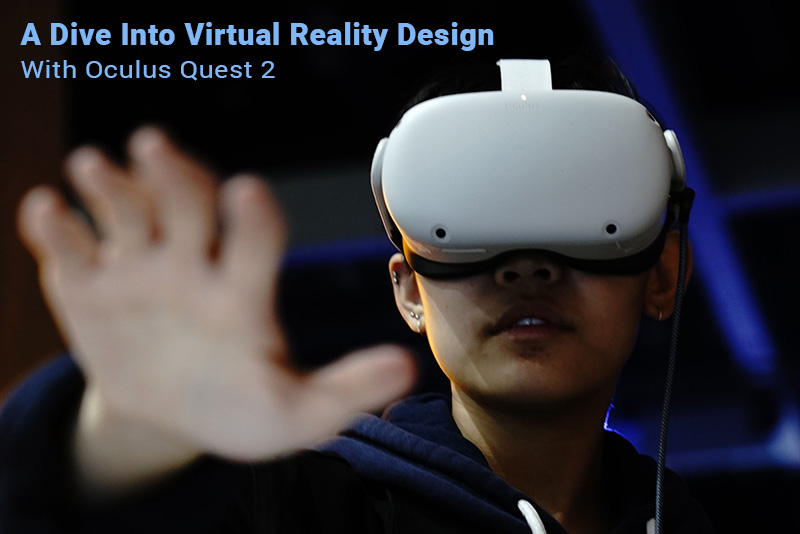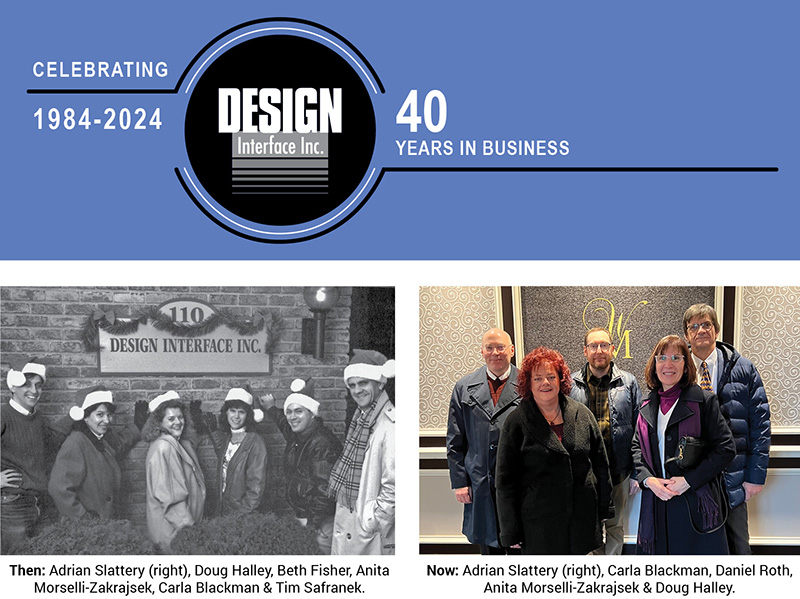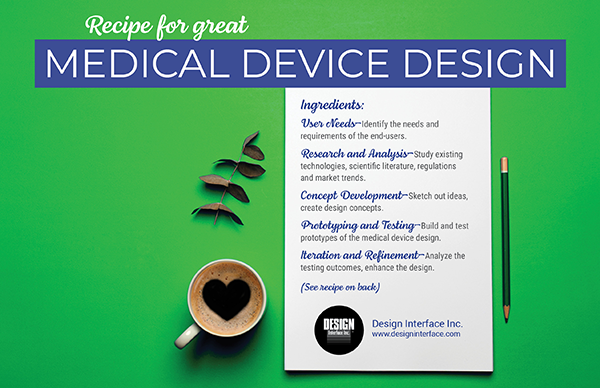BLOG

Wondering how to make a splash at your next trade show?
Look no further for the solution you need! At Design Interface, we specialize in creating captivating graphics that not only capture attention but also embody your brand essence, ensuring your space commands the spotlight. Standing out on a bustling show floor becomes effortless with our expertise. Our mission is to create an outstanding design, making it accessible to all.
• Display Graphics
• Booth Design
• Hand Outs
• Signage
• Tradeshow Graphics & Displays
Design Interface Inc. can show you what is possible. Our forward-thinking solutions for product design, package design, medical device design, graphic design, and photography unlock the value of your ideas as we communicate your message and goals. See more here: https://designinterface.com/
Check Out Our Latest Product Animation Reel
We are thrilled about the introduction of the XSTIM Spine Fusion Stimulation Therapy device, which incorporates state-of-the-art capacitive coupling technology to stimulate bone growth. The Xstim Spinal Fusion Stimulator is an FDA-approved class 3 device, clinically demonstrated to enhance bone healing post spinal fusion surgery or for individuals in need of treatment due to a failed fusion from a prior surgical procedure. Design Interface has collaborated with XSTIM over the past year to develop engineering blueprints and a product animation for their newest innovation.
Design Interface Inc. can show you what is possible. Our forward-thinking solutions for product design, package design, medical device design, graphic design, and photography unlock the value of your ideas as we communicate your message and goals. See more here: https://designinterface.com/

Sketching Designs In Virtual Reality (VR) With Oculus Quest
Our team at Design Interface recently tested the Oculus Quest 2 headset for Virtual Reality (VR) design using the Gravity Sketch app. Led by Daniel Roth, who has experience designing a Little Tikes toy at the Cleveland Institute of Art, our goal was to try out this technology.
Oculus Quest 2 impressed us with its well-designed Meta product, consisting of a headset with built-in computing power and two hand wands for drawing control. The User Interface (UI) is integrated into the screen, and hand controllers with buttons enhance the drawing experience.
A notable feature was the straightforward integration of the User Interface (UI) into the screen, with hand controllers acting as digital brushes and palettes. This intuitive process, coupled with real-time responsiveness, made the VR design experience user-friendly.
The Teams’ User Experience (UX) Reactions:
Daniel: “Gravity Sketch is a great tool for working out ideas in broad strokes (similar to sketching). The interface with Sub-D surfaces is especially good. One thing I have found is that it lacks granular control. Everything is loose and gesture-based, and some finesse would make it that much better. As far as downsides, my main complaint is that I wish there were more adjustments for people who wear glasses. Also, I get headaches after being in VR for too long.”
Anita: “I liked the feel of the headset on my head. It was not too heavy and did not bother my nose or eyes. It was very cool to see the whole object in 3D. The instructions were clear and easy to follow, along with the steps to start the program. The controllers would take some getting used to, but they felt comfortable in my hands. I did not get the chance to draw with it, so I cannot give my opinion on its use as a drawing tool. I would be very interested in using it.”
Adrian: “An exciting and novel way of approaching the sketch.” It’s a bit clumsy like the Ford Model T, but this is a new way, and it will only get better and more precise with time. Add a little verbal instruction to an AI engine, and the virtual sky is the limit.”
Doug: “I was impressed with the immersive environment and appeared to track well with my head movements. I felt a little woozy afterward. This might be useful for designing larger objects like furniture or cars, but I wonder how useful it is for smaller items with detail.”
Carla: “It really is a different reality and takes some getting used to for spatial awareness. Weird, but interesting! I can’t say I want to jump in and do all my sketching with this. It did cause some nausea and a slight headache afterward.”
Design Interface Inc. can show you what is possible. Our forward-thinking solutions for product design, package design, medical device design, graphic design, and photography unlock the value of your ideas as we communicate your message and goals. See more here: https://designinterface.com/

What is Corporate Identity & Why It Is Important for a Strong Brand
Corporate identity is like a company’s personality. It’s how a business acts, talks, and is seen by people. This includes the company name, logo, colors, and how it presents itself to the public. Design Interface recently completed the corporate identity program shown above.
A strong corporate identity is important because it helps a company be recognized by its customers and stand out from competitors. Everyone in the company, like the employees and investors, plays a part in creating this identity.
One big part of corporate identity is the design, like the logo and colors used by the company. This helps the company look unique and different from others.
Now, there’s a difference between branding and corporate identity. Branding is about a specific product and its features, while corporate identity is about the whole company and its values.
Brand identity is about how a company wants to be seen by its customers. It’s the message that customers get from the company. Keeping this message consistent is important for customers to remember and trust the brand.
Why is all of this important? Well, a solid corporate identity helps a company in many ways:
Builds customer loyalty: Customers become loyal when they connect with a brand’s values.
Enhances reputation: Consistent identity and good service build trust.
Creates awareness: A clear identity makes a brand easy to recognize.
Helps with differentiation: Standing out from competitors is easier with a strong identity.
So, having a positive corporate identity is a big deal for any company, whether big or small. It helps shape how people see the company, leading to more success in the market.
If you want to improve your company’s identity, Design Interface can help. We specialize in making it easy for companies to manage their brand and create a positive image. Contact us to learn more!
Design Interface Inc. can show you what is possible. Our forward-thinking solutions for product design, package design, medical device design, graphic design, and photography unlock the value of your ideas as we communicate your message and goals. See more here: https://designinterface.com/

Celebrating 40 Years
Our Story
For 40 years, Design Interface has been the go-to source for turning new product ideas into reality. Through three recessions and a loyal client base, we’ve stood the test of time.
Back in 1976, Carla and Adrian met at Central St. Martin’s in London, both graduating with BA (Hons) degrees in Industrial Design and later earning MBAs. According to them, the real deal with Design Interface is that it gave them control over their lives.
Carla kicked off the business in 1984 with freelance graphics after her MBA. Adrian, also armed with an MBA, joined later. The first client, Rossborough Manufacturing, came in 1984, coincidentally Adrian’s employer at the time. With a one-year-old son, David, in tow, Adrian left his job in 1987, and the second child, Jenna, arrived. That’s when the business expanded, taking on more industrial design work and larger projects.
Anita Morselli-Zakrajsek and Douglas Halley, our stellar employees, have been crucial to our success, sticking with us for over 30 years and consistently delivering exceptional work. We owe much of our journey to their dedication. Also, we recently added a new CIA alumnus, Daniel Roth, to our industrial design team.
Design Interface Inc. can show you what is possible. Our forward-thinking solutions for product design, package design, medical device design, graphic design, and photography unlock the value of your ideas as we communicate your message and goals. See more here: https://designinterface.com/
To view our full history go to the Design Interface legacy book at: https://designinterface.com/wp-content/uploads/2023/04/DI_HISTORY_BOOK_LAYOUT_010923.pdf

Out With The Old, In With The New
After nine years of service at Design Interface, our pair of trusty Mojo printers are finished. Kudos to Stratasys for creating an easy to use, reliable machine, unfortunately, have discontinued support. Enter the new Bambu printer – it’s fast, can print a variety of materials, and makes bigger prints (build volume: 10x10x10 inches).
Oh, and we can’t leave out the FormLabs printer, which prints resin prints in many materials, including clear! (See our last post about colorizing resin prints).
The printer service is open for business, and the prices range from $20-$40 depending on the size and complexity of the part. Contact us at 440-871-0600 or info@designinterface.
Design Interface Inc. can show you what is possible. Our forward-thinking solutions for product design, package design, medical device design, graphic design, and photography unlock the value of your ideas as we communicate your message and goals. See more here: https://designinterface.com/
How to Add Color to Clear 3D Resin Prints
Interested in dying a resin print?
Well, we’ve been working on prototypes involving soft flexible components for a client. Typically, these prints are clear and colorless. However, when one of our prints failed, we decided to experiment with dying a 3D print. After some research, we discovered that all we needed was some alcohol-based ink.
Since the resin is alcohol-based, the dye chemically bonds and doesn’t wear off like paint would. We were surprised at how easy and effective this technique turned out to be. Stay tuned as we share our experience with using alcohol-based ink to add color to clear resin prints, providing a simple yet effective solution for our prototypes.
Design Interface Inc. can show you what is possible. Our forward-thinking solutions for product design, package design, medical device design, graphic design and photography unlock the value of your ideas as we communicate your message and goals. See more here: https://designinterface.com/

Pantone Color of the Year 2024: Peach Fuzz
With all of the color predictions rolling in at the end of the year, the most anticipated one is Pantone’s Color of the Year— For 2024 it is Pantone 13-1023, Peach Fuzz. “A cozy peach hue softly nestled between pink and orange, Peach Fuzz brings belonging, inspires recalibration, and an opportunity for nurturing, conjuring up an air of calm, offering us a space to be, feel, and heal and to flourish from whether spending time with others or taking the time to enjoy a moment by ourselves,” says Leatrice Eiseman, Executive Director, Pantone Color Institute.
The announcement of the heartfelt hue marks the 25th anniversary of Pantone’s Color of the Year initiative. “In the spirit of PANTONE 13-1023 Peach Fuzz, we reflect back on the last 25 years of the Pantone Color of the Year program grateful to provide an avenue where designers and color enthusiasts all over the world can engage in a conversation about color, be inspired by color and showcase their creativity within their communities. We look forward to continuing this for many more years to come.” added Laurie Pressman, Vice President of the Pantone Color Institute.
To read more about Peach Fuzz and how the color is chosen go to: https://media.hubspot.com/meet-the-woman-who-decides-the-color-of-the-year-1?ecid=ACsprvvKfZ8ZKNQ5FQrMtZCoz61WC6EYY-jVV_SZ1tGo9IN2Pfth46YLhpn4EI7r4kUdQcyzcy5_&_hsmi=282106975.
Design Interface Inc. can show you what is possible. Our forward-thinking solutions for product design, package design, medical device design, graphic design, and photography unlock the value of your ideas as we communicate your message and goals. See more here: https://designinterface.com/

XSONX Revolutionizes Wound Care with New Device
At Design Interface Inc., innovation is not just a goal; it’s a commitment to transforming ideas into reality. We are thrilled to introduce our latest creation, the XSONX Wound Hygiene System – a revolutionary medical device designed to elevate the standard of wound care.
The Genesis of Innovation
The XSONX Wound Hygiene System is the result of collaborative efforts between our talented team at Design Interface Inc. and the visionary inventor behind this groundbreaking technology. From concept to creation, we dedicated extensive development time to perfecting every detail, ensuring a product that meets and exceeds expectations. Adrian Slattery, the head of the design team, expressed, “Having dedicated many years to its development, I’m gratified to see it delivers more comfortable care for the patient.”
Micro-Vibrational Technology: A Game-Changer in Wound Care
The core of XSONX lies in its cordless system, which is equipped with micro-vibrational technology. This cutting-edge feature allows for the powerful yet gentle cleaning and debridement of chronic and contaminated wounds. We understand the importance of precision in medical devices, so substantial testing, including trials with wound care professionals, was conducted to refine the system.
During the development phase, our team utilized orange peel for initial testing, a testament to our commitment to thorough and responsible testing procedures. Patient safety and comfort are paramount, and we left no stone unturned to ensure that the XSONX Wound Hygiene System delivers on its promises.
Features that Redefine Wound Care
The XSONX Wound Hygiene System boasts a range of features that set it apart:
• Slough and Biofilm Removal: The device effectively removes slough and biofilms, promoting a cleaner wound environment conducive to optimal healing.
• Low-Frequency Vibrations: Operating at frequencies below 2.5kHz, the system minimizes pain perception, offering a more comfortable experience for wound care patients.
• Simplified Healing: By simplifying wound hygiene, the XSONX system eliminates barriers to healing, providing a cost-effective and efficient alternative to current approaches.
Breaking Away from the Norm: XSONX vs. Current Approaches
Traditional wound care methods often involve sharp scalpel debridement associated with higher pain levels. The XSONX Wound Hygiene System challenges this norm, offering a pain-reducing solution that enhances the healing process.
The XSONX Wound Hygiene System offers versatility with three distinct wound heads: Scrubbing Head (#1): Ideal for thorough cleaning of wounds. Small Debriding Head (#4S): Designed for precision in debriding smaller areas. Debriding Head (#4): Offering a broader debriding capability for larger wound areas.
Visit the XSONX website at https://xsonx.com/ to find out more.
Unlock the potential of your ideas with Design Interface Inc. Our innovative solutions in product design, package design, medical device design, graphic design, and user experience (UX) go beyond aesthetics. We create meaningful solutions that make a difference, effectively communicating your message and goals. Explore the transformative impact of our forward-thinking designs at https://designinterface.com/.

Designing is like cooking—it is all about the right ingredients in the right amount to make it delicious.
Step into the kitchen of innovation, where the art of culinary creation finds its parallel in the meticulous process of crafting exceptional medical devices. In this recipe for success, we distill the complex endeavor of medical device design into five essential steps, each playing a vital role in the final masterpiece. Just as a chef combines ingredients with precision, we combine research, creativity, and refinement to bring forth the recipe for achieving greatness in medical device design.
Step 1: User Needs
Just like any good recipe starts with understanding the taste preferences of the diners, a successful medical device design begins by identifying the needs and requirements of the end-users. Engage with healthcare professionals, patients, and other stakeholders to understand their challenges, expectations, and desired outcomes.
Step 2: Research and Analysis
Similar to gathering the necessary ingredients and understanding their properties before cooking, thorough research and analysis are crucial in medical device design. Study existing technologies, scientific literature, regulations, and market trends. Identify potential risks and limitations, while also considering ethical considerations.
Step 3: Concept Development
Just as a chef imagines a dish and plans the recipe, it’s time to brainstorm and develop concepts for your medical device. Sketch out ideas, create design concepts, and evaluate their feasibility, functionality, and potential impact. Consider factors such as usability, ergonomics, aesthetics, and manufacturability.
Step 4: Prototyping and Testing
Just as a cook prepares a sample dish to taste and refine, it’s essential to build prototypes of the medical device design. Utilize rapid prototyping techniques, 3D printing, or other suitable methods to create physical or virtual models. Test the prototypes rigorously, considering performance, safety, durability, and user feedback. Iterate and refine the design based on the test results.
Step 5: Iteration and Refinement
Like adjusting seasoning or making slight modifications to improve a dish, the final step involves iteration and refinement of the medical device design. Analyze the testing outcomes, and incorporate feedback from users, medical professionals, and regulatory requirements. Enhance the design, address any identified issues, and optimize the medical device’s functionality, reliability, and user experience.
As the final garnish is placed thoughtfully to elevate a dish, the meticulous execution of each step in this recipe enriches the world of medical device design. Just as a memorable meal lingers on the palate, let these principles leave a lasting imprint in your approach to innovation. With this recipe as your guide, may your future endeavors in medical device design be nothing short of a culinary masterpiece that revolutionizes healthcare and enhances well-being.
Design Interface Inc. can show you what is possible. Our forward-thinking solutions for product design, package design, medical device design, graphic design, and photography unlock the value of your ideas as we communicate your message and goals. See more here: https://designinterface.com/

